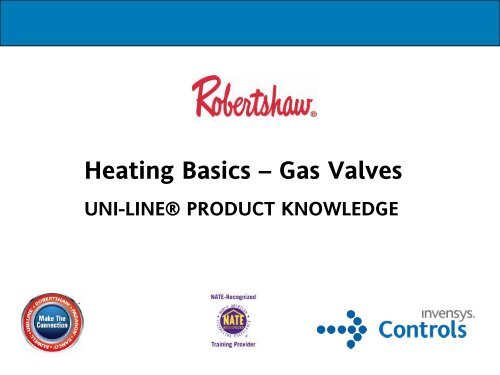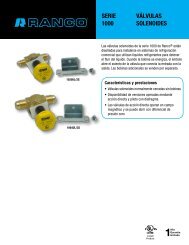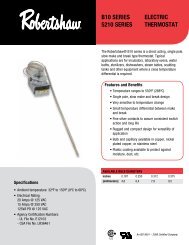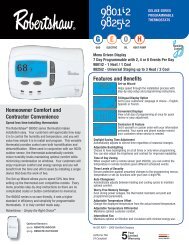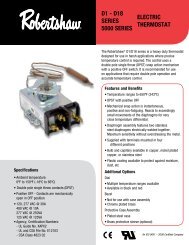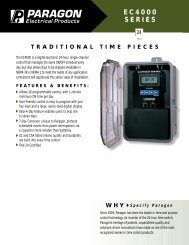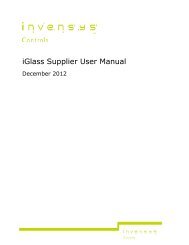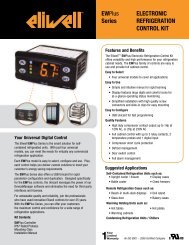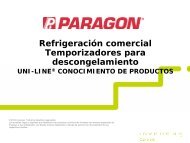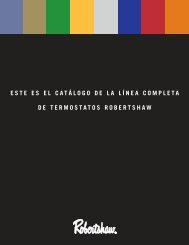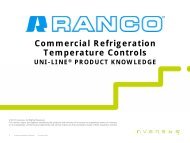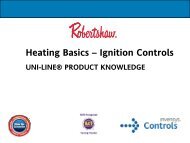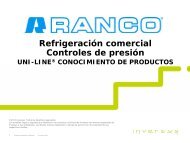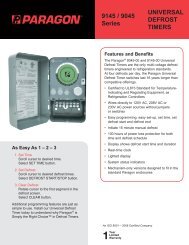Gas Valves - Uni-Line
Gas Valves - Uni-Line
Gas Valves - Uni-Line
- No tags were found...
You also want an ePaper? Increase the reach of your titles
YUMPU automatically turns print PDFs into web optimized ePapers that Google loves.
Heating Basics – <strong>Gas</strong> <strong>Valves</strong>UNI-LINE® PRODUCT KNOWLEDGE
Subjects We Will Cover In This SessionFuelBTUIgnition MethodsPressure (controlled and uncontrolled)Pilot Basics<strong>Gas</strong> <strong>Valves</strong>Installation TipsApplications and ReferenceCompetitionWhen You Have QuestionsQ&A
FuelNATURAL GAS CHARACTERISTICS L.P. (PROPANE)0.64 Specific Gravity 1.531000 BTU’s/cu. Ft. 25007”wc – 10.5”wcService PressureRange11”wc – 14”wc1200 deg. F Ignition Temperature 950 deg. F.10/1 CombustionAir/<strong>Gas</strong> Ratio24/1Important Takeaways: Natural gas is lighter than air and rises.L.P. gas is heavier than air and “puddles” in the lowest area it can find.
BTU (British Thermal <strong>Uni</strong>ts)Definition of a BTU – The quantity of heat required to raisethe temperature of one pound of water one degree Fahrenheit.Many gas appliances are sold (rated) depending on their BTUoutput. The more heat needed, the higher the BTU rating.Example… Residential gas water heaters (regardless of fuel) arerated between 15,000 and 75,000 BTU. Anything over 75,000BTU is considered a Commercial water heater. Commercialwater heaters are rated between 75,000 and 750,000 BTU.
Ignition Systems3 TYPES OF IGNITION SYSTEMSStanding pilot – Pilot is manually ignited and stays on constantly. Whenthe thermostat calls for heat, assuming that the pilot flame is making goodcontact with the thermocouple, the gas valve allows gas to flow to the mainburner until the call for heat is satisfied. Least expensive, least efficient.Intermittent pilot (also known as “spark to pilot”) – Pilot is ignited by aspark generated by an ignition module and electrode when the thermostatcalls for heat. When enough heat is generated in the thermocouple, the gasvalve allows gas to flow to the main burner and is ignited by the pilot untilthe call for heat is satisfied. More expensive, more efficient.Direct spark and HSI (Hot Surface Ignition) – When the thermostat calls forheat, the main burner is ignited by a direct spark or ceramic (glow bar)igniter. Eliminates the pilot, but requires an expensive flame sensor andmore expensive ignition module. Most expensive, most efficient.
PressureNATURALL.P.Inlet Pressure 7” – 10” WC 14” – 17” WCOutlet Pressure 3” – 4” WC @ 1” PD 10” – 11” WC @ 1”PDInteresting Facts Regarding Pressure: Excessive inlet pressure will not necessarily cause the gas valve to lock up.However, the valve will not regulate pressure correctly. <strong>Gas</strong> line pressure from utilities vary seasonally with demand. During peakusage, inlet pressure can drop well below the 7” WC Natural gas shownabove. High rise buildings may experience low pressure on upper floors (especiallyduring cold weather). Many times a 2 psig system is used to compensate. In some instances OEMs will specify higher outlet pressures to obtain BTUrates beyond the capabilities of the gas valve at 1” pressure drop. If an OEMspecified an outlet pressure of 5” WC Natural gas and the inlet pressuredropped to 6” WC or less, what would happen?
Pilot Basics
Pilot BasicsThermocouple Construction“Hot” JunctionCopper-NickelAlloyCopper-IronAlloy“Cold” JunctionInsulatedCopperWireContactButtonUUUUUUULoad(Safety Magnet)Copper SheathFittingNutContact Button
Pilot BasicsThermopile ConstructionHotJunctionsColdJunctions1951 SeriesCoaxialConnectorUUUUUULoad(Safety Magnet)UUUUUULoad(<strong>Gas</strong> Valve)1950 SeriesTwin LeadConnector
Troubleshooting for PilotsProper Pilot FlameCorrect Flame Tip of Thermocouple orThermopile is 3/8" to 1/2" into pilotflame.Noisy, Lifting, Blowing Flame High <strong>Gas</strong> Pressure Wrong Pilot OrificeLazy Yellow Flame Clogged Primary Air Opening Low <strong>Gas</strong> Pressure Clogged Pilot OrificeWavy Blue Flame Draft Condition at PilotHard Sharp Flame High <strong>Gas</strong> Pressure Pilot Orifice too SmallSmall Blue Flame Wrong Pilot Orifice Size Low <strong>Gas</strong> Pressure Clogged Pilot Tube
7000 <strong>Gas</strong> Valve Designed for:– Intermittent Pilot– Direct Spark– Hot Surface Incorporate the following:– Manual Valve– Pilot Valve– Main <strong>Gas</strong> Pressure Regulator Applications include:– Central Heating <strong>Uni</strong>ts– Wall Heaters– Boilers– Mobile Home Furnaces Easy to install and easy to adjust
7200 <strong>Gas</strong> Valve Designed for:– OEM Replacements Incorporate the following:– Manual Valve– Pilot Valve– Main <strong>Gas</strong> Pressure Regulator– Dual Automatic <strong>Valves</strong>– Adjustments on top of Valve Opening Configurations– Standard– Slow Opening– Step Opening– <strong>Uni</strong>versal Model– <strong>Uni</strong>versal 2-stage Model
<strong>Gas</strong> Valve Actuator Types Manual – A standing pilot valve that is manually turned “ON” and “OFF” foreach heating cycle. Millivolt – Wall thermostat actuated combination gas valves. The controlscombine a manual gas cock, automatic pilot safety valve and a millivoltoperator. The automatic pilot safety is separate from the gas cock andprovides gas shutoff in case of pilot outage. Millivolt gas valves do notrequire an external power source. 24 Volt, 120 Volt, and 240 Volt – These gas valves combine a manual mainand pilot gas valve, a separate automatic safety pilot valve, pilot filtration, andan automatic electric valve. Hydraulic – The thermostat is built into the gas valve. Temperature issensed by a bulb at the end of a capillary tube. By placing the bulb in thereturn air stream, return air is sensed and the valve is actuated to open andclose by the hydraulic system in the control. Temp. knob on valve or remote(18” from valve). Standard capillary length with temp. knob on dial is 36”.Capillary on remote knob is 48”. Multiple temp. ranges available.
<strong>Gas</strong> Valve Installation TipsSelect Type of <strong>Gas</strong>– Natural <strong>Gas</strong>– Liquid PropaneDetermine– Inlet and Outlet Size– BTU Requirement– Ignition Method to be Used– Outlet Pressure Setting Requirement– Ambient Temperature– Physical Dimensions where <strong>Gas</strong> Valve will be Mounted– Orientation of <strong>Gas</strong> Valve• <strong>Valves</strong> should not to be mounted upside down– Valve Type: 24 Volts, Millivolt, Hydraulic, <strong>Line</strong> Voltage– Opening Speed of <strong>Gas</strong> Valve
Basic Troubleshooting For <strong>Gas</strong> SystemsCondition Possible Cause Possible CureFlame too large 1. Outlet pressure too high 1. Reset with manometer2. Defective regulator 2. Replace3. Orifice too large 3. Replace with correct sizeNoisy flame 1. Excessive primary air 1. Adjust air shutter2. Noisy pilot 2. See Pilot Troubleshooting slide3. Burr in orifice 3. Remove burr or replace orificeYellow tip in flame 1. Too little primary air 1. Adjust air shutter2. Clogged burner ports 2. Clean burner ports3. Misaligned orifices 3. Realign orifice and burnerFloating flame 1. Blocked venting 1. Inspect vent and clean2. Insufficient primary air 2. Adjust air shutterDelayed ignition 1. Improper ign. source location 1. Reposition ignition source2. Pilot flame too small 2. Check orifice and clean3. Burner ports clogged 3. Clean burner ports4. Low outlet pressure 4. Adjust pressure regulator
Basic Troubleshooting For <strong>Gas</strong> SystemsCondition Possible Cause Possible Cure Failure to ignite 1. Main gas “OFF” 1. Open manual valve2. Poor electrical connections 2. Check, clean, & tighten3. Defective gas valve 3. Replace with new4. Defective thermostat 4. Replace with new Burner won’t turn “OFF” 1. Poor thermostat location 1. Relocate thermostat2. Defective thermostat 2. Replace with new3. Defective gas valve 3. Replace with new Rapid burn cycles 1. Clogged furnace filters 1. Clean or replace2. Excessive t’stat anticipation 2. Adjust t’stat anticipator3. Poor thermostat location 3. RelocateWhen all else fails…… Check to make sure gas supply ahead of the gas valve is in the“ON” position.
CENTRAL HEATINGSERIES & PAGEIN UNI-LINE®CATALOGRATE(BTU) @1” PDNAT/LPMIN/MAXCAPACITYBTUSTANDINGPILOTINTERMIT.PILOTDIRECTIGNITIONTEMP. RATING7000StdNat. 300,00010,000 – 400,000UNI-LINE 700Y Y Y -40 to 175 FPages 68, 69,73- 82LP. 485,00010,000 – 560,0007000 HCNat. 600,000200,000 – 800,000UNI-LINE 700Y Y Y -40 to 175 FPages 68, 73-75, 77-80LP. 972,000300-000-1,150,0007200Nat. 150,00015,000 – 200,000UNI-LINE 720Y Y Y -40 to 175 FPages 85-87LP. 240,00015,000 – 320,0007222Nat. 100,00010,000 – 135,000Not in catalogN Y Y -40 to 175 FLP. 157,00016,000 – 216,0002000DER/IPERNat. 125,00025,000 – 170,000UNI-LINE 722N Y (IPER) Y (DER) -40 to 175 FPage 88LP. 200,00025,000 – 272,000
SPACE HEATING & HEARTHSERIES & PAGE IN UNI-LINE® CATALOGRATE(BTU) @1” PDMIN/MAXCAPACITY BTUSTANDINGPILOTINTERMIT.PILOTDIRECTIGNITIONTEMP. RATING7000StdNat. 300,00010,000 – 400,000UNI-LINE 700Y Y Y -40 to 175 FPages 68, 69, 73- 82LP. 485,00010,000 – 560,0007200Nat. 150,00015,000 – 200,000UNI-LINE 720Y Y Y -40 to 175 FPages 85-87LP. 240,00015,000 – 320,0002000DER/IPERNat. 125,00025,000 – 170,000UNI-LINE 722N Y (IPER) Y (DER) -40 to 175 FPage 88LP. 200,00025,000 – 272,0007500Nat. 100,0006,700 – 160,000N/A UNI-LINEY N N 0 TO 185 FNot in catalogLP. 162,00012,000 – 226,0007000LC & SLCNat. 40,0005,000 – 70,000UNI-LNE 710Y N N -40 to 225 FPages 83-84LP. 65,0005,000 – 100,0007000STNat. 300,00010,000 – 400,000UNI-LINE 700Y N N 32 – 175 FPages70-71LP. 485,00010,000 – 560,000
COMMERCIAL WATER HEATINGSERIES & PAGE INUNI-LINE®CATALOGRATE(BTU) @1” PDNAT/LPMIN/MAXCAPACITYBTUSTANDINGPILOTINTERMIT.PILOTDIRECTIGNITIONTEMP. RATING7000StdNat. 300,00010,000 – 400,000UNI-LINE 700Pages 68, 69, 73- 82LP. 485,00010,000 – 560,000Y Y Y -40 to 175 F7000 HCNat. 600,000200,000 – 800,000UNI-LINE 700Pages 68, 73-75, 77-80LP. 972,000300-000-1,150,000Y Y Y -40 to 175 F7200Nat. 150,00015,000 – 200,000UNI-LINE 720Pages 85-87LP. 240,00015,000 – 320,000Y Y Y -40 to 175 F7222Nat. 100,00010,000 – 135,000Not in catalogN Y Y -40 to 175 FLP. 157,00016,000 – 216,0002000DER/IPERNat. 125,00025,000 – 170,000UNI-LINE 722Page 88LP. 200,00025,000 – 272,000N Y (IPER) Y (DER) -40 to 175 F
COMMERCIAL COOKINGSERIES & PAGEIN UNI-LINE®CATALOGRATE(BTU) @1” PDNAT/LPMIN/MAXCAPACITY BTUSTANDINGPILOTINTERMIT.PILOTDIRECTIGNITIONTEMP. RATING7000StdNat. 300,00010,000 – 400,000UNI-LINE 700Y Y Y -40 to 175 FPages 68, 69,73- 82LP. 485,00010,000 – 560,0007200Nat. 150,00015,000 – 200,000UNI-LINE 720Y Y Y -40 to 175 FPages 85-87LP. 240,00015,000 – 320,0007222Not in catalogNat. 100,000LP. 157,00010,000 – 135,00016,000 – 216,000 N Y Y -40 to 175 F2000DER/IPERNat. 125,00025,000 – 170,000UNI-LINE 722N Y (IPER) Y (DER) -40 to 175 F.Page 88LP. 200,00025,000 – 272,0007500Nat. 100,0006,700 – 160,000N/A UNI-LINEY N N 0 TO 185 FNot in catalogLP. 162,00012,000 – 226,0007000LC & SLCNat. 40,0005,000 – 70,000UNI-LNE 710Y N N -40 to 225 FPages 83-84LP. 65,0005,000 – 100,000TS11J & KNat. 195,000NAUNI-LINE 1720Y N N 32 – 300 FPages 411-413LP. 195,000NA
RESIDENTIAL WATER HEATINGSERIES & PAGE INUNI-LINE®CATALOGRATE(BTU) @1” PDNAT/LPMIN/MAXCAPACITYBTUSTANDINGPILOTINTERMIT.PILOTDIRECTIGNITIONTEMP. RATING220RNat. 86,00010,700 – 107,000UNI-LINE 110Y N N 32 – 175 deg. F.Pages59-61LP. 100,0007,000 – 140,000R103RVNat. NANA / NAUNI-LINE 110Y N N 32 – 175 deg. F.Page 59LP> 35,0003,500 – 35,000R110RNat. 86,00010,700 – 107,000UNI-LINE 110Y N N 32 – 175 deg. F.Page 61LP. 100,0007,000 – 140,000*7222WDERNat. 100,00010,000 – 135,000Not in catalogN N Y(HS) 32 – 175 deg. F.LP. 157,00016,000 – 216,0002000DER/IPERNat. 125,00025,000 – 170,000UNI-LINE 722N Y (IPER) Y (DER) -40 to 175 deg. F.Page 88LP. 200,00025,000 – 272,000*2000WIPERNat. 100,00010,000 – 125,000Not in catalogN Y (IPER) N 32 to 175 deg. F.LP. 157,00016,000 – 216,000
Robertshaw versus Other ManufacturersMarketsSpace &CentralHeatingRobertshaw® US basedEngineeringand Tech.ServicesHoneywellUS basedEngineeringand Tech.ServicesWhite RodgersUS basedEngineering andTech. ServicesDexenNo Eng orTech.Services(TaiwanCo.)SITUS basedEngineeringand Tech.Services(Italian Co.)YES YES YES YES YESRes. WaterHeatingYES YES YES NO NOHearthProductsYES NO NO YES YESPilots,Thermocouples,IgnitionsystemsYES YES YES NO PILOTSONLY
When you have Questions? Technical Service 1-800-445-8299 Fax 1-630-260-7243 Customer Service 1-800-304-6563 Fax 1-800-426-0804 <strong>Uni</strong>-<strong>Line</strong>® Catalog Website: www.<strong>Uni</strong>-<strong>Line</strong>.com Cross Reference Website:www.uni-line.com/templates/xrefsearch.aspx General Information Websites:Robertshaw ® , Paragon ® , Eliwell, Ranco ® , and Publication Zone ®www.InvensysControls.comwww.RobertshawTstats.comwww.ToolBox.InvensysControls.com/templates/Login.aspx


